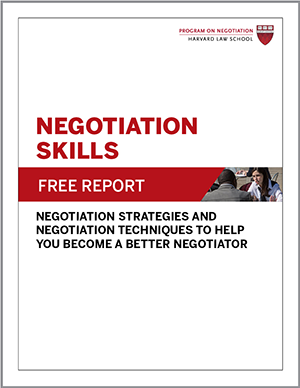
What exactly is a mutually beneficial agreement?
Some negotiation experts would have you believe that a mutually beneficial agreement is one in which each side grabs as much as it can from a finite pot of resources and calls it a day.
At the Program on Negotiation, we urge you to aim higher by combining such competitive value-claiming with collaborative value creation. Not because it’s the “nice” thing to do, but because it’s been proven to be the best path to a truly mutually beneficial agreement.
Negotiators often fail to reach a mutually beneficial agreement because they bring a win-lose mindset to the negotiation table. It is true that in a small number of deals and disputes, negotiators have no choice but to haggle over just one issue, and that is usually price. For example, if you are haggling over the price of a rug in a foreign bazaar, you may have trouble finding ways to expand the conversation and bring other issues to the table.
In the vast majority of business negotiations, however, many more issues beyond price are involved. When negotiating a purchasing deal, for example, you and your counterpart might talk about not only price, but also delivery, service, financing, possible future business deals, performance bonuses, and so on.
Don’t make the mistake of viewing such complexity as a liability. In fact, the opposite is true. When multiple issues are on the negotiation table, you gain the ability to brainstorm mutually beneficial tradeoffs with your partner. Through tradeoffs, you can achieve more than you would have if you had simply compromised on each issue. In the process, you increase your odds of reaching a mutually beneficial agreement.
Suppose, for example, that getting a strong service contract from your potential supplier is very important to you. If financing terms matter less to you, you might ask for a beefed-up service contract while offering financing terms that the supplier favors. You can still push hard to claim value on each issue, but you should have a larger pie to divide than when you got started.
How does this type of value creation play out in the real world? Here are a few examples to make note of:
- After years of stalemate, the management of New York City’s Lincoln Center for the Performing Arts reached a deal in 2014 to regain lucrative naming rights to Avery Fisher Hall, home to the New York Philharmonic, by paying $15 million to Fisher’s descendants. A mutually beneficial agreement was only reached after Lincoln Center management identified and addressed the family’s key concern that a planned renovation of the hall was in line with their late patriarch’s goals.
- In 2012, Facebook CEO Mark Zuckerberg persuaded Instagram founder Kevin Systrom to sell his photo-sharing app for $1 billion. The deal came about after a series of friendly meetings between the two moguls in which they shared their business philosophies and, crucially, Systrom revealed the value he placed on maintaining Instragram’s independence from Facebook.
- After months of fruitless negotiations, Microsoft reached a deal to acquire Finnish mobile-phone company Nokia in 2013. A breakthrough came only after Nokia stipulated conditions to negotiating, including the requirement that Microsoft set up a financing source for Nokia.
How can you create value at the bargaining table and get on the path to a mutually beneficial agreement? Here are three tips from Harvard Business School’s Max H. Bazerman:
1. Share information.
Negotiators often fear they will give away too much if they express their true preferences on various issues. But expressing preferences isn’t the same as giving away your bottom line. “Our last supplier burned us with poor service, so that issue is critical to us,” you might say to a potential supplier. “What are some of your key concerns?”
2. Ask questions.
Don’t make the common mistake of viewing negotiation as primarily an exercise in trying to persuade the other party to do what you want them to do. With that mindset, you will be so focused on your talking points that you won’t listen closely enough to what your counterpart has to say. By contrast, listening actively and asking lots of questions will help you collect the information you need to develop a mutually beneficial agreement.
3. Make multiple equivalent simultaneous offers (MESO).
Business negotiators tend to present one offer at a time. If the offer is rejected, they learn very little new information that would help them to move forward. A better approach is to craft three offers that are different across issues but equally appealing to you. The other party may reject all three of the offers, but is likely to communicate which one she likes best—and put you back on a track toward a mutually beneficial agreement.
Do you have experience with a mutually beneficial agreement? Share your story in the comments.





